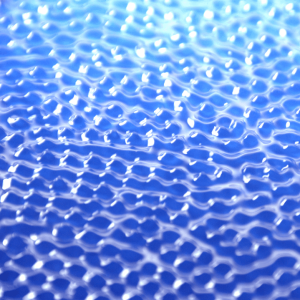Run, Faraday, Run

The APS Division of Fluid Dynamics has announced the 2022 winners of its annual Gallery of Fluid Motion video and poster contest. UNC Mathematics is extremely proud that this year’s first place prize was given to James Guan and his team for their work with Faraday waves.
This is an excerpt. The full article was published on November 28, 2022, and can be accessed here.
Faraday Waves Get Moving
It’s one of those classic physics classroom demonstrations: water in a shallow vessel placed on top of a speaker producing a loud tone generates ripples on the liquid surface. These “Faraday waves” can form a range of patterns that are normally stationary, but the ripples will move around chaotically when the sound amplitude is large. Pedro Sáenz of the University of North Carolina, Chapel Hill, and postdoctoral researcher Jian Hui Guan wondered if this chaotic motion could be converted to coherent motion by restricting the space where the waves move. The researchers set up the liquid in a circular channel and were thrilled to see that the waves moved around the loop in an orderly way. The desired behavior appeared on the first try. “This is something that will happen once in my life,” Sáenz jokes.
The video from Sáenz, Guan, and their colleagues, shows that this coherent motion can proceed either clockwise or counterclockwise by random chance, but it can also be forced in one direction by adding a sort of staircase pattern (“ratchet”) to the walls of the channel. The researchers show that this steady motion of surface waves can also be guided through a more complicated channel network and can potentially be arranged to power a pump that could move another fluid through a separate channel. They titled the video Run, Faraday, Run to playfully refer to a famous line, “Run, Forrest, run,” from the movie Forrest Gump.
